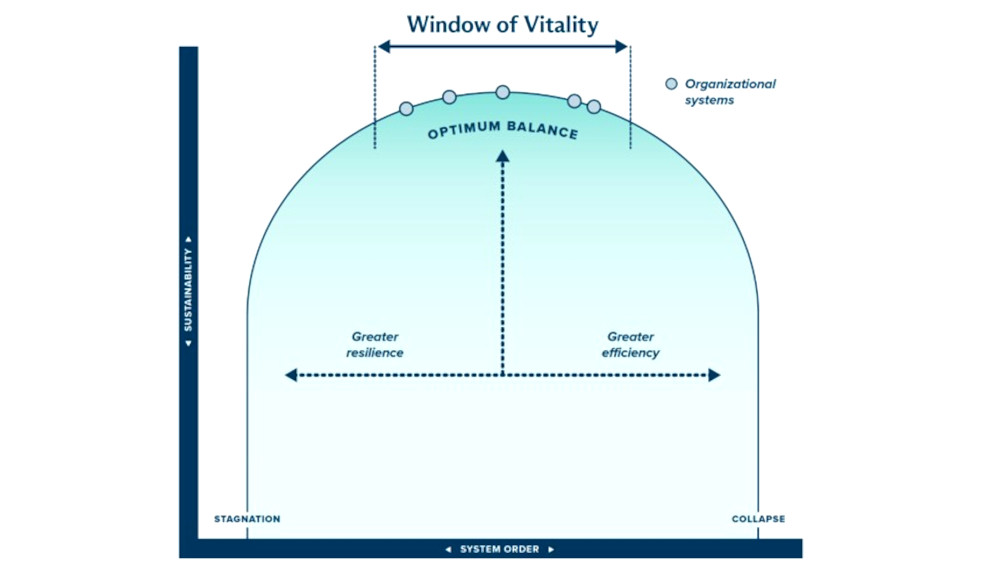Are you familiar with the “window of
vitality”?
It refers to the idea that functioning ecosystems exist within a range of what
ecologists call “system
order.”
These ecosystems avoid breaking down over time because they balance efficiency
(the optimum use of resources) with resilience (the capacity to adapt to
change).
To illustrate the concept, let’s take an example from urban planning — where
swamps and creeks are concreted over to support housing and infrastructure
development. Most years, this ‘solution’ deals well with light to moderate
rainfall by allowing excess water to drain quickly and efficiently. When the
deluge comes, though, the impervious surface prevents groundwater
recharge
— water percolating through microscopic gaps in rock and soil to the aquifer
below — overwhelming the stormwater system that functions so well in standard
conditions and mass flooding devastates the precinct.
Urban planners now recognize the importance of water-sensitive urban
design, which
minimises wastewater and preserves waterway health and groundwater recharge.
Unfortunately, broader corporate culture has been slower to learn such
principles — tending to overinvest in efficiency (draining waterways) at the
expense of resilience (preserving waterways).
Mired in the short-termism of the quarterly earnings cycle, many investors and
company bonus structures incentivize management teams to optimize for cost and
efficiency. More common still is the assumption that the future will be the same
as the recent past. This also spurs executives to prioritize efficiency over
resilience (which assumes change).
By contrast, the hallmarks of
resilience
— sustainability, flexibility, diversity and learning — are viewed as optional
at best and wasteful at worst.
The lesson from nature is that successful organizations stay within their own
window of vitality by understanding and balancing the tension between efficiency
and resilience.

A case study in Google
Consider Google, whose founders created one of the world’s most successful
businesses by allocating a meaningful portion of firm resources to
‘non-productive’ innovation.
Borrowing the idea from 3M, co-founders Sergey Brin and Larry
Page
instituted the 20%
Project — where
employees were encouraged to spend up to a fifth of their time working on
personal projects. In a culture that prized individual freedom and celebrated
creativity, employees invented cash-gushing creations including AdSense,
Gmail and Google News.
Ironically, the 20% Project was discontinued in 2013 after excessive management
oversight of new ideas and an overt focus on efficiency stifled its intended
innovation.
In the decade since, Google has trended further towards hyper-efficiency at the
expense of the blue-sky thinking of its engineers. OpenAI’s
ChatGPT,
for example, leapfrogged Google Bard in the race to
monetize large language models — despite the latter having deeper pockets and
more AI talent.
CEO Sundar Pichai and CFO Ruth Porat remain outstanding business
leaders. But in my view, they can do more to ensure Google remains within the
window of vitality.
Restoring an optimum balance between efficiency and resilience at Google might
include the following steps:
-
Restart the 20% Project: Explain to investors that short-term costs are
the price of creativity and innovation, and a necessary bulwark against
future disruptions.
-
Minimum percentage of investment for ‘other bets’: Defend moonshot ideas
such as Waymo (self-driving cars) and
Calico (longevity) from the vagaries of the
economic cycle.
-
Modularize project teams: Hire and promote people especially good at
adapting to change and faster cycles of knowledge acquisition.
-
Invest in resilience: Set aside a resilience fund to respond quickly to
unforeseen future disruptions and to support the evolution of the business
model over time.
-
Talent redistribution:
AI is
undermining the value of average engineers. Trim the engineering team and
reinvest in other disciplines (e.g. physics, sustainability).
-
Ethical use of AI: Work with major competitors to develop a framework to
guide the development and use of AI to ensure AI-generated content is
accurate and safe.
-
Invest in trust: Use DeepMind to showcase
how AI can help solve humanity’s greatest challenges — burnishing Google’s
reputation as a champion for the common good.
3 steps to bolster your company's resilience
Like Google, has your business over invested in efficiency at the expense of
resilience? If so, what steps can you take to right the balance? Here are three
to consider:
-
We recommend a megatrends analysis as part of the materiality-assessment
process, to better understand
how changes in the operating environment might affect your business.
-
Science-based climate-scenario
analysis
is another critical strategy that will help you prepare for an unknown
future. Disclosure is now mandatory in many jurisdictions.
-
Finally, consistent reporting on ESG performance can ensure your
organization sees the bigger picture — allowing it to learn and adapt over
time.
As Nassim Taleb says,
“Never cross a river if it is, on average, four feet deep.” To succeed over the
long term, always prepare for the flood.
Get the latest insights, trends, and innovations to help position yourself at the forefront of sustainable business leadership—delivered straight to your inbox.
Luke Heilbuth is CEO of BWD — a sustainability advisory firm with offices in Sydney and New York.
Published Jan 28, 2024 8am EST / 5am PST / 1pm GMT / 2pm CET